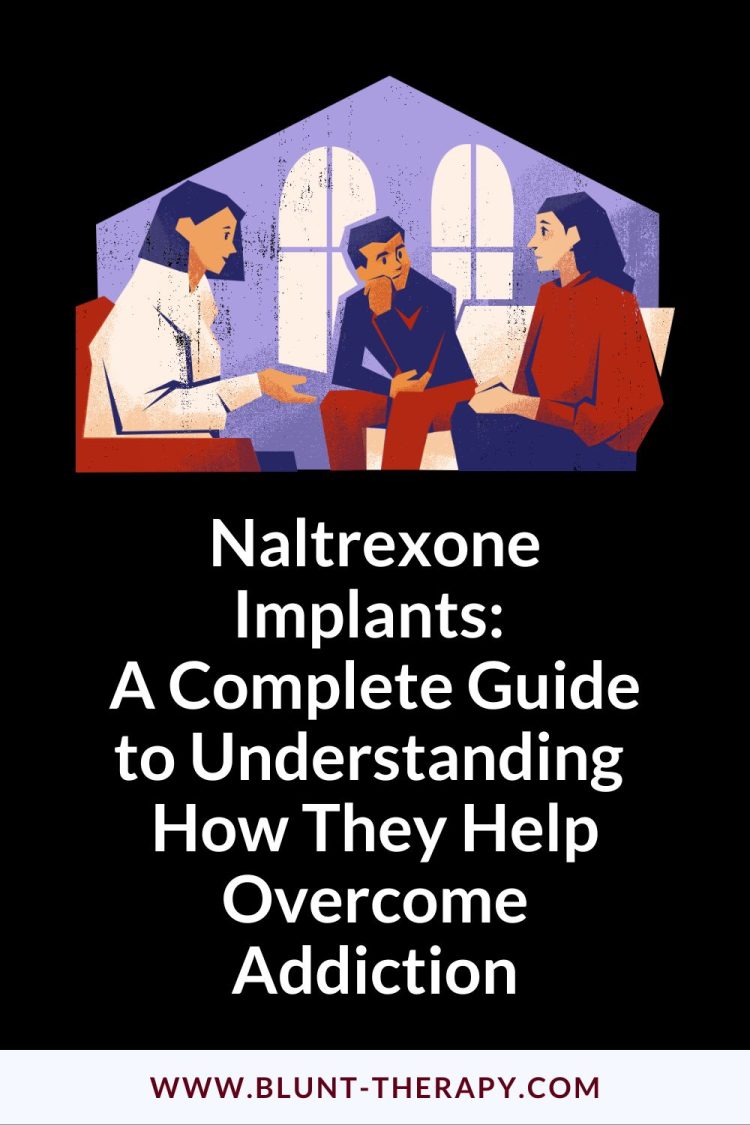Table of Contents
Affiliate link notice: As an affiliate of BetterHelp and other third-party vendors, We will receive compensation if you make a purchase using the links provided on this page. For more information, visit our disclosure page.
Last Updated on September 16, 2025 by Randy Withers
Addiction—whether to alcohol, prescription painkillers, or illicit opioids—is more than a bad habit; it is a chronic brain disease. It rewires the brain’s reward system, hijacking normal pleasure pathways so that drugs or alcohol become the main source of reward and motivation. Each use strengthens these neural pathways, making the brain crave the substance even after detox.
For many people, the question is not “Can I stop?” but “How can I stop without relapsing?” Because even after completing detoxification, the cravings remain intense. Studies show that relapse rates after detox alone are extremely high—often more than half of patients return to substance use within weeks or months. The reason is simple: the brain has been conditioned to seek the substance, and willpower alone is rarely enough to resist these deep-seated cravings.
Traditional oral medications like naltrexone can help by blocking the pleasurable effects of opioids or alcohol, reducing cravings and supporting abstinence. But there’s a major limitation: they must be taken every single day. Skipping doses—even unintentionally—can create a window of vulnerability, where relapse becomes more likely. For many, maintaining this strict adherence over weeks or months proves too difficult.
If daily pills feel like a constant struggle, a naltrexone implant may be worth considering. By releasing a steady dose of medication under the skin over several weeks or months, it can take the pressure off having to remember a daily pill. For someone struggling with cravings, it offers a way to maintain continuous protection while focusing on therapy, rebuilding relationships, and creating a stable routine. In other words, it could serve as a reliable support system that helps you stay on track without relying solely on willpower.
In short: Naltrexone implants answer the critical question that haunts every person in recovery—“How can I stay protected from relapse every day?”—by offering continuous, reliable support where oral medications often fall short.

What is a Naltrexone Implant?
A naltrexone implant is a small, solid device placed under the skin—most commonly in the lower abdomen or upper arm—that gradually releases naltrexone over several weeks or months. This method ensures continuous delivery of medication, keeping blood levels steady without the need for daily pills.
Key points:
● Duration of effect: Depending on the type of implant and formulation, a single insertion can last anywhere from 3 to 12 months. This long-acting effect means patients do not need to worry about remembering a daily dose, helping to prevent gaps in treatment that could lead to relapse.
● Complete opioid receptor blockade: The implant works by occupying the brain’s opioid receptors without activating them. This means that if a patient uses opioids such as heroin, oxycodone, or fentanyl while the implant is active, they will not experience the usual euphoric “high.” This reduces the motivation to use these substances and helps prevent relapse.
● Reduction of alcohol’s rewarding effect: For alcohol use disorder, naltrexone interferes with the brain’s reward pathways, making drinking less pleasurable and less reinforcing. Patients often report that alcohol no longer provides the same sense of satisfaction, which can help them maintain abstinence and resist cravings.
● Support for recovery beyond medication: By stabilizing the body’s response to substances, the implant allows patients to focus on therapy, lifestyle changes, and rebuilding relationships. It provides a pharmacological foundation for recovery, giving behavioral treatments and support programs a better chance of success.
● Safety and predictability: Because the drug is delivered steadily over time, the implant reduces the peaks and troughs associated with oral medication, lowering the risk of breakthrough cravings or accidental overdose.
How Naltrexone Implants Work
For Opioids:
Naltrexone acts as an opioid receptor blocker. It binds to the receptors in the brain that normally respond to opioids, but it does not activate them. This means that if someone takes heroin, oxycodone, fentanyl, or other opioids while the implant is active, they will not experience the euphoric “high.” Over time, this changes the brain’s reinforcement pattern—since the expected reward does not occur, the motivation to use opioids decreases.
Example: A patient with a history of daily heroin use may usually feel intense euphoria after a dose. With a naltrexone implant in place, the same dose produces no pleasure, helping the patient resist the urge to continue using and supporting long-term abstinence.
For Alcohol:
Naltrexone works by modulating the brain’s endogenous opioid system, which is involved in the pleasure and reward of drinking. Alcohol normally triggers the release of endorphins, making drinking enjoyable and reinforcing the habit. Naltrexone dampens this effect, reducing the pleasurable sensations associated with alcohol, which in turn lowers cravings and helps patients avoid relapse.
Example: Someone who used to feel a strong “buzz” or sense of relief from a glass of wine may find that after the implant is inserted, drinking no longer gives the same satisfaction. Over time, this diminishes the desire to drink, making abstinence easier to maintain.
Benefits of the Implant Compared to Oral Medication
1. No daily pill to remember:
Many patients struggle with adherence to oral medications. Missing even a single dose of oral naltrexone can leave a window of vulnerability where relapse is possible. With the implant, the medication is delivered continuously, removing this daily responsibility.
2. Less temptation to skip doses:
Even motivated patients may occasionally skip oral doses due to forgetfulness, travel, or personal stress. The implant eliminates this risk, providing continuous protection regardless of daily circumstances.
3. Constant blockade helps maintain abstinence:
Oral medications often lead to peaks and troughs in blood levels. If a patient misses a dose, they may feel cravings return strongly. The implant keeps steady blood levels, meaning cravings are continuously suppressed and the protective effect against both alcohol and opioid relapse is maintained.
Example: A patient who previously relapsed every time they forgot their morning pill now experiences a full month of continuous protection. Even stressful days, social events, or travel do not create gaps in the medication’s effectiveness, giving them a stable foundation to focus on therapy, family, and life changes.
Who Can Benefit From a Naltrexone Implant?
1. People with repeated relapse despite detox or oral medications
Many individuals complete detox programs or take daily oral medications, only to relapse because cravings remain strong and adherence is difficult. Naltrexone implants provide continuous, long-acting protection, reducing the risk of relapse even during stressful or challenging periods.
Example: A patient who relapsed multiple times while taking daily naltrexone tablets may achieve their first extended period of abstinence after switching to an implant, because the medication works steadily without relying on daily memory or willpower.
2. Individuals who want to avoid opioid agonist therapy (methadone or buprenorphine)
Some patients prefer a treatment approach that does not involve taking opioid substitutes long-term. Naltrexone implants are non-opioid, non-addictive, and completely block the effects of opioids. This allows patients to remain opioid-free while still protecting against relapse.
Example: A person who struggled with the idea of remaining on methadone can choose an implant instead, gaining the security of opioid blockade without maintaining dependence on another opioid.
3. Those seeking a “set-and-forget” approach with long-term protection
Daily medications can be challenging for anyone, especially people juggling work, family, or unstable life circumstances. Implants deliver medication continuously for weeks or months, removing the need to remember a daily dose and reducing the temptation to skip medication.
Example: Someone with a busy schedule or chaotic lifestyle can receive an implant and know they are protected for several months, allowing them to focus on therapy, rebuilding relationships, and creating a stable routine.
What the Research Says
Clinical Trials and Studies on Naltrexone Implants
1. Randomized Controlled Trials (RCTs) Demonstrating Efficacy
● RCT Comparing Naltrexone Implant to Oral Naltrexone: A randomized trial found that patients receiving the naltrexone implant had higher rates of continuous abstinence compared to those on oral naltrexone. Specifically, 61% of the implant group maintained abstinence at 12 months, versus 40% in the oral group. This study also reported no major adverse events associated with the implant. Source
● Randomized Trial of Long-Acting Sustained-Release Naltrexone: Another study hypothesized that patients receiving the naltrexone implant would experience more retention and less opioid use and relapse than those receiving oral naltrexone. The results supported this hypothesis, indicating the implant’s effectiveness in reducing opioid use and enhancing treatment retention. Source
2. Observational Data from Western Australia
● Hospital Morbidity and Mortality Study: Research in Western Australia involving 437 heroin-dependent individuals treated with naltrexone implants demonstrated significant reductions in opioid-related hospital admissions. The odds of overdose-related hospitalizations decreased by 77% (odds ratio [OR] 0.23) compared to those receiving methadone treatment. This suggests that naltrexone implants may offer superior protection against overdose-related hospitalizations. Source
● Pilot Study on Adolescent Heroin Users: A pilot study assessing the impact of naltrexone implants on accidental opiate overdose in high-risk adolescent heroin users indicated a reduction in overdose incidents among those receiving the implant, highlighting its potential benefits in younger populations. Source
3. Meta-Analyses and Systematic Reviews
● Cochrane Review on Sustained-Release Naltrexone: A systematic review and meta-analysis found moderate-certainty evidence that sustained-release naltrexone reduces illicit opioid use compared to treatment as usual. However, the evidence regarding treatment retention and acceptability was less conclusive, with some studies indicating improved retention rates. Source
● Systematic Review and Meta-Analysis on Extended-Release Naltrexone: Another meta-analysis aimed to compare extended-release naltrexone (XR-NTX) and oral naltrexone for treating substance use disorders. The findings suggested that XR-NTX may offer advantages in treatment retention and reduced relapse rates compared to oral naltrexone. Source
Benefits of Naltrexone Implants
1. Continuous protection from opioid or alcohol effects
Naltrexone implants deliver medication steadily over several weeks or months, keeping blood levels consistent. This continuous blockade of opioid receptors ensures that even if a patient attempts to use opioids, they will not experience the euphoric effects. Similarly, for alcohol, naltrexone reduces the pleasurable reinforcement of drinking.
Supported insight: Continuous protection is especially valuable for individuals who struggle with daily pill adherence, as it eliminates gaps in medication coverage that could trigger relapse. Observational studies in Western Australia showed reduced
hospitalizations and overdoses in patients using implants, illustrating the real-world benefits of steady receptor blockade.
2. Reduces cravings and the “reward” of substance use
Naltrexone works by interfering with the brain’s reward pathways. Opioids and alcohol normally trigger the release of dopamine and endorphins, creating pleasure and reinforcing use. Naltrexone dampens this response, making substance use less rewarding and cravings less intense over time.
Example: A patient who previously felt strong pleasure from drinking alcohol may find that after implant insertion, alcohol no longer produces the same satisfaction. Over time, the reduced reward helps weaken the learned association between substance use and pleasure, supporting sustained recovery.
3. Increases likelihood of remaining in treatment and maintaining abstinence
Treatment retention is a major challenge in addiction recovery. Daily oral medications often see dropout rates as high as 50–60%, primarily due to missed doses or relapse. Naltrexone implants provide a long-acting, low-maintenance intervention that helps patients stay engaged in treatment programs for longer periods.
Supporting evidence: Clinical trials have shown retention rates of up to 70% at 12 weeks with naltrexone implants, compared to approximately 40% for oral naltrexone users. Patients with implants also remain abstinent 3–4 times longer on average than those taking oral medication, highlighting the impact of continuous pharmacological support.
Risks and Considerations of Naltrexone Implants
Absolute Contraindications
1. Current opioid use
Naltrexone is a potent opioid antagonist, meaning it blocks opioid receptors in the brain. If a patient is actively using opioids at the time of implant insertion, naltrexone can precipitate severe withdrawal, which may include intense pain, nausea, vomiting, anxiety, and even life-threatening complications in vulnerable patients. Therefore, patients must be fully detoxified from opioids before receiving an implant.
Supporting insight: Clinical guidelines universally recommend confirming opioid-free status with urine drug screens or supervised detox prior to implantation. This ensures patient safety and prevents precipitated withdrawal.
2. Acute hepatitis or severe liver disease
Naltrexone is metabolized in the liver. Patients with active liver disease or significantly impaired liver function are at higher risk of hepatotoxicity if exposed to the medication. Baseline liver function tests (LFTs) are mandatory, and patients with elevated enzymes or liver failure should not receive the implant.
Supporting evidence: Studies monitoring liver function during naltrexone therapy have shown that mild, reversible increases in liver enzymes can occur, highlighting the importance of careful patient selection and monitoring.
3. Known allergy to naltrexone or implant materials
Hypersensitivity reactions to either naltrexone or the implant’s components are rare but possible. Any history of allergy contraindicates use, as continuous exposure via an implant could provoke severe local or systemic reactions.
Potential Risks
1. Reduced tolerance after implant ends → higher overdose risk if relapse occurs
During the period the implant is active, the body’s tolerance to opioids decreases because the receptors are blocked. If a patient relapses once the implant wears off, they may take doses that would have been tolerable previously, increasing the risk of overdose.
2. Possible liver enzyme elevation → requires baseline and periodic monitoring
Naltrexone can occasionally elevate liver enzymes, especially in patients with pre-existing liver conditions or heavy alcohol use. Regular LFTs before and during treatment help identify early signs of liver stress and allow for timely intervention.
3. Implant site complications: minor infection, irritation, or extrusion
Because the therapy involves a minor surgical procedure, local complications can occur:
● Infection: Rare, but can usually be treated with antibiotics.
● Irritation or pain: Mild discomfort at the insertion site is common in the first few days.
● Extrusion: Rarely, the implant may partially or fully exit the skin, requiring replacement.
What to Expect During Treatment
Step 1: Medical Assessment
● Complete detox from opioids if needed: Ensures the patient is opioid-free, preventing severe withdrawal when the implant is inserted.
● Blood tests to check liver function and overall health: Confirms the patient can safely metabolize naltrexone and identifies any conditions that could increase risk.
Step 2: Implant Insertion
● Minor outpatient procedure under local anesthesia: Minimizes pain and risk; no need for hospitalization.
● Small incision; implant placed under the skin: Delivers continuous medication while being minimally invasive and easy to monitor.
Step 3: Recovery and Monitoring
● Local site healing takes a few days: Ensures proper wound care and reduces risk of infection or complications.
● Regular follow-ups with the doctor to monitor liver function, mental health, and relapse prevention: Keeps treatment safe, tracks progress, and allows early intervention if issues arise.
Step 4: Psychosocial Support
● Counseling, therapy, and community support remain critical: Addresses the behavioral and emotional aspects of addiction that medication alone cannot fix.
● Implant provides pharmacological support, but behavioral support maximizes recovery success: Combining medication with therapy improves long-term abstinence and overall quality of life.
Long-Term Outlook
Naltrexone implants are not a “magic bullet,” but when combined with counseling, behavioral therapy, and community support, they provide a reliable pharmacological foundation for recovery. By continuously blocking the effects of opioids or reducing the rewarding effects of alcohol, implants help break the vicious cycle of craving, relapse, and overdose, giving patients a better chance at long-term abstinence.
1. Sustained Abstinence
Many patients experience months of continuous abstinence for the first time in years after receiving an implant. Unlike daily oral medications, which are prone to missed doses and gaps in protection, implants maintain steady blood levels of naltrexone. This consistent blockade reduces the immediate risk of relapse and gives patients time to engage in therapy and rebuild healthy habits.
Example: Observational studies in Western Australia showed that patients using implants remained opioid-free for extended periods, with some maintaining abstinence for six months or longer, compared to significantly shorter periods with oral therapy.
2. Improved Quality of Life, Work Performance, and Relationships
By reducing cravings and stabilizing the patient’s response to substances, implants allow individuals to focus on rehabilitating their social and professional lives. Patients often report:
- Better concentration and productivity at work
- Strengthened family relationships and social connections
- Increased ability to plan for the future and participate in daily routines
Supporting insight: One study noted that patients who remained on naltrexone implants were more likely to attend counseling sessions, maintain employment, and engage in social activities, demonstrating the ripple effect of pharmacological stability on overall life functioning.
3. Community-Level Impact
Programs and clinics that adopt naltrexone implants have observed reductions in overdose rates and hospital admissions at the population level. For example, Western Australia saw notable decreases in opioid-related emergency presentations after wider adoption of implants. While causality is complex and influenced by other interventions, the trend indicates that sustained-release naltrexone can enhance public health outcomes when used as part of coordinated addiction treatment programs.
Supporting example: Community clinics reported fewer opioid-related hospitalizations, reduced demand for emergency services, and lower overdose mortality among populations with high implant uptake. This demonstrates that the benefits extend beyond individual patients, contributing to safer communities and reduced strain on healthcare systems.
Final Thoughts
Naltrexone implants offer long-term, consistent protection, helping patients regain control over their lives. When paired with behavioral therapy, counseling, and social support, they not only reduce substance use but also improve overall well-being, strengthen relationships, and provide measurable public health benefits.
They are a critical tool in modern addiction treatment, bridging the gap between medical intervention and meaningful life recovery. If you are interested in pursuing treatment, it is important that you first speak with your doctor to get appropriate counsel on where to begin and what steps you will need to take to go forward.
To learn more about how to get treatment with naltrexone implants, visit this article.







